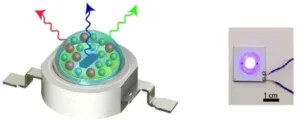In many ways, Quantum Dots (QDs) are well suited as a basis for white light emitting LEDs. They are not, however, fully optimised for this application. More specifically, up till now, the efficiency achieved with QD materials has been limited.
One approach that has been investigated to address this issue is based on a combination of fluids and optics known as optofluidics. There are two reasons that such an approach is attractive. The first is that QD materials incorporated in a fluid are amenable to simple integration into a device. The second is that the optical properties of the fluid can be changed as needed by adjusting the ratio of the component liquids. The positive aspect of the optofluidic approach is that it has demonstrated high quantum yield and tunable electronic properties. None-the-less, the specific task of implementing an optofluidic approach in an efficient solid state lighting device has proved difficult. This is due, in part, to a decrease in the quantum yield exhibited when QDs synthesized in a liquid state are embodied in a solid state host matrix. This is known as the host material effect.
Advancing the state of the art in usng liquid QDs in lighting applications was the object of an investigation by a team of researchers headed by Sadra Sadeghi of the Graduate School of Materials Science and Engineering at Koç University (Istanbul, Turkey).
Recent results on this topic by the researchers was published in an article entitled “Quantum dot white LEDs with high luminous efficiency.” It was published in Vol. 5, No. 7 / July 2018 / Optica 793. A copy of the article can be downloaded here.
The implementation of the liquid QD approach adopted by the researchers starts with covering a blue LED with a transparent PDMS (polydimethylsiloxane) polymeric dome-like lens. A schematic of the so-called liquid QD-LED is presented in the left hand portion of the figure below. The lens was then filled by injecting a liquid containing a mixture of colloidal QDs. In the figure, the red and green spheres represent red and green emitting QDs. The QDs absorb the blue light emitted by the LED die and emit red and green light. By balancing the output of the red and green QDs and the blue LED die, the emissions combine to produce white light. The right hand portion of the figure is a photograph of a liquid QD-LED emitting white light.
Left: Schematic of the liquid QD-LED. Right: Photograph of a liquid QD-LED emitting white light.
The polymer lens was reported as mechanically stable. In addition, it was found capable of self-repairing the holes in its surface caused by the needle used to inject the liquid. That is, the lens was found not to leak.
Paraphrasing the technical article, the team reports that, by using high quantum yield and wavelength tuneable QDs directly from their synthesis in a liquid state, the researchers were able to suppress the host material effect and reabsorption attributed to conventional QD host matrices when the devices are realized in the solid state.
The technical article discusses the details of the design and fabrication of a prototype liquid QD-LED device. In the prototype, the quantum yield of red and green emitting QDs were maximized by optimizing synthesis parameters. The yields were up to 84%. A “balanced” amount of the liquid containing QDs was injected into the lens in which the blue LED die was mounted. The research article reports that the white light emission from the LED had 105 lm/W green – blue based white light generation and an overall luminous efficiency of 64 lm/W.
Compared to more conventional approaches, this level of performance represents a twofold increase in efficiency to that of incorporating QDs in polydimethylsiloxane film and a six fold enhancement of efficiency to that of incorporating QDs in close packed formation.
The researchers’ listed three key aspects of their new approach to the integration of QDs into white light emitting LEDs.
- High efficiency was achieved by the liquid state integration. The luminous efficiency was increased by more than 50% due to the suppression of the host material effect.
- As the quantum yield of the QDs increased, the ratio of emitted photons to absorbed photons increased significantly. The result is more efficient color conversion and, consequently, a LED with improved white light production efficiency.
- Device materials and fabrication were adjusted so as to keep the peaks of the wavelengths of light emitted by the LED close to that of the maximum sensitivity of the human eye.
In their article, the researchers also point out that performance could be further increased by using blue LED die with higher external quantum efficiency, refractive index matching and use of a back reflector.
The researchers also presented theoretical predictions indicating that the luminous efficiency of liquid QD-LEDs could reach over 200 lm/W. Based on the validity of these predictions, the researchers believe that liquid state integration of QDs holds great promise for the production of efficient white light emitting LEDs. -Arthur Berman

